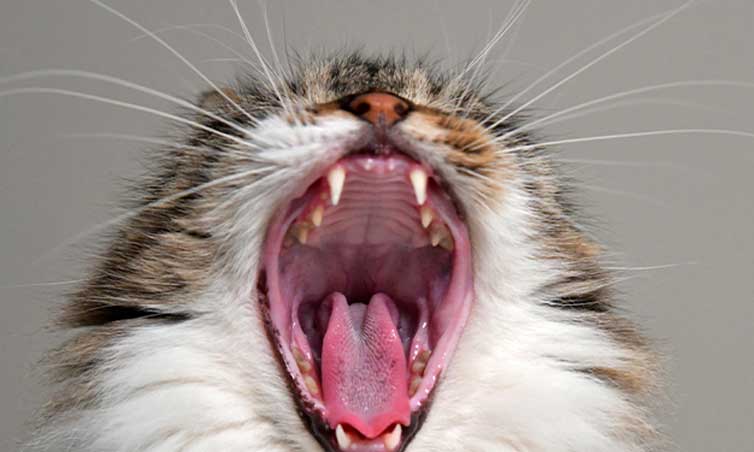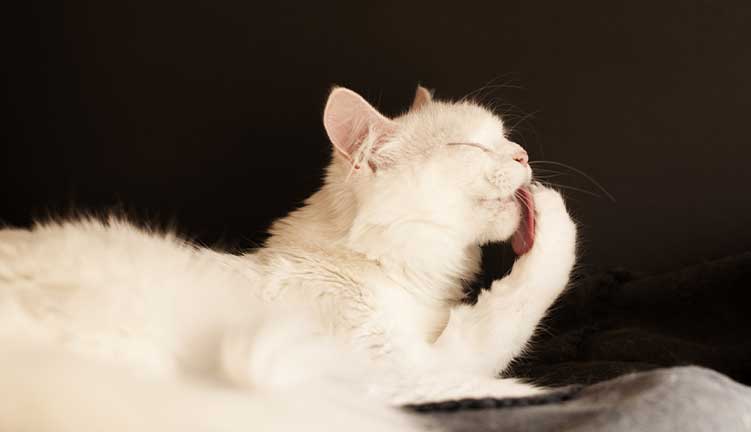Deworming Cats: Preventing Intestinal Parasites
Intestinal parasites can wreak havoc on your poor cat’s insides, leading to serious medical issues that may even develop into health conditions if gone untreated. Invest in your cat’s long-term health by sticking to a strict cat deworming schedule. Learn why deworming kittens and cats is so important, how cats contract worms, the types of worms and more.
CATS

Posted by bravectosouthafrica – 27 November 2020
Deworm a Cat and Ensure Good Health for Your Feline Friend and Family
Don’t make the mistake of thinking that only feral cats are prone to contracting intestinal worms and parasites. Your beloved housecat can also become infected with these horrible little beasts. But do not fear! You’ll be pleased to hear that it is a rather common issue for most cats and kittens. If the cat worming routine is practised regularly, there usually isn’t any long-lasting or serious consequences, but this can depend on the type of parasite the cat is infested with. A heavy burden of worms in the cat may also lead to more serious issues (more on that later).
Did you know? Deworming cats isn’t just beneficial to your cat’s health but to your and your family’s health as well. Some worms that infect cats can be passed along to humans. In some rare cases, this can even be the cause of serious disease in humans – another reason to take deworming for cats seriously.
To deworm your cat frequently shows that you care. Remember: prevention is always better than cure. On your next trip to the vet, you can ask about which dewormer is right for your cat.
How Do Cats Contract Intestinal Parasites and Worms?
Cats can become infected by worms in various ways, depending on various factors. These include:
- Nursing from the mother (i.e. queen) and consuming contaminated milk
- Eating, licking, rolling in, sniffing or stepping in contaminated soil
- Consuming infected prey such as birds, reptiles and rodents
- Through flea, tick and mosquito bites or through ingesting of one of these pests while grooming
- Coming into contact with other infected cats and animals
- Coming into contact with infected faeces or vomit from another animal
- Through contact with slugs and snails
Worms in Kittens
A kitten or younger cat tends to become infected with worms either by inheriting the infection from their mother or by ingesting larvae via their mother’s milk.
Worms in Adult Cats
Mature felines are likely to become infected with worms through contact with other infected animals, by eating prey or parasites like fleas infected with worms or by accidentally consuming the eggs or larvae of worms such as while eating grass outside.

Deworming Against the Most Common Types of Cat Worms
Just like the plenty of ways in which a cat can contract worms, there are also various types of worms they can become infected with. Meet some of the most common culprits:
Roundworms in Cats
This is the world’s most common type of intestinal parasite. The two most common feline roundworm types are known as Toxocara cati and Toxascaris leonina. Eggs from these parasitic worms are passed on through faeces. These eggs are tough and can remain viable in the environment for a number of years.
Roundworms can infect cats in one of two ways: either through (accidental) ingestion directly from the contaminated environment or through the consumption of an intermediate host, such as a mouse contaminated with the parasite.
Toxocara cati can also be passed along from a queen to her kittens via her milk. When cats become infected with roundworms, some immature larvae may remain dormant in the cat’s body tissues. It doesn’t necessarily cause any harm to a mature cat, but when females fall pregnant these tiny larvae may migrate to their mammary glands, from where they are excreted, along with any milk, when nursing.
In terms of appearance, roundworms are long, white and wet spaghetti-like. They absorb all the nutrients they need from their infected host. To accurately determine whether a cat is infected with roundworms, a vet will need to collect and analyse a fecal sample in the lab.

Hookworms in Cats
The hookworm is the smallest kind of common intestinal roundworm found in cats. These parasitic worms are found across most countries in the world but aren’t equally common everywhere.
They primarily reside in the cat’s small intestine, where they feed on the hosts’ blood. Hookworm infection can lead to damage of the intestinal lining. They attach to the surface of a host’s intestines, which could ultimately lead to anaemia, bleeding and weight loss. This is especially dangerous when left untreated in kittens.
The most common ways in which hookworms infect cats are:
- Through (accidental) ingestion of its eggs, directly from the environment
- Feeding on an infected intermediate host
- Larvae found in the environment burrow through the cat’s skin
Some of the most common kinds of hookworms include Ancylostoma tubaeforme and Uncinaria stenocephala.

Tapeworms in Cats
A tapeworm is a long, flat worm with a segmented body. Once one of the egg-containing segments at the end of the tapeworm has matured, it is released and passed on through the faeces. If you happen to notice rice grain-like objects in your cat’s faeces, around their anus or on their bedding, then there’s a good chance that they may be suffering from a tapeworm infestation.
For a tapeworm to complete its lifecycle, it first needs an intermediate host to consume its eggs from the environment. Cats tend to become infected by going on to eat this intermediate host such as a bird or a flea. The animal that ends up acting as an intermediate host will vary and depends on the specific species of tapeworm. Two of the world’s most common tapeworm species known to infect cats are Dipylidium caninum and Taenia taeniaeformis.
Cats get infected by Dipylidium caninum through fleas. An immature flea larva eats some of the tapeworm’s eggs. This infected larva develops into an infected flea which, in turn, is ingested by a cat while grooming. If your cat is infested with fleas, it is likely that it also has tapeworms.
Taenia taeniaeformis is contracted when a cat feeds on rodents such as mice and rats. These rodents will have eaten infected tapeworm eggs from the environment. Cats who enjoy hunting are likely to contract tapeworm this way.

Heartworms in Cats
Cats can contract heartworms through infected mosquitoes. For around six months, worms (called Dirofilaria immitis), transmitted by the infected mosquitos, will move throughout the cat’s body before finally coming to a halt in its circulatory system, i.e. the heart and pulmonary arteries.
It should be noted that heartworms are exclusively transmitted through the bite of an infected mosquito and cannot be transferred between or within species. These worms are both treatable and preventable if caught early on, but if it’s not diagnosed and treated before the advanced stages, it may prove fatal.

Why It’s Important to Look Closely: The Signs and Symptoms of Worms in Cats
Knowing whether or not there are worms in your cat’s intestines can be tricky, as there may not be any visible symptoms if the infection isn’t severe. By the time your feline friend is displaying clear signs of a worm infestation, the problem has usually worsened significantly. That’s why it’s so important to deworm your cat back to back.
General signs and symptoms of a worm infestation in cats include, but aren’t limited to, the following:
- Weight loss, usually accompanied by a noticeable decrease or increase in appetite
- A pot-bellied look, i.e. a distended stomach
- Vomiting
- Lethargy
- Chronic coughing
- Chronic soft stools/diarrhoea
- A dull coat which may feature hair loss, as well as an irritated or inflamed skin
- Dragging or rubbing their bottom across the ground
- Worms can be seen as rice grain-like objects in the infected cat’s stool (roundworms and tapeworms)
- Worms can also be identified by tapeworm segments attached to the fur/skin surrounding the anus
If you suspect that your cat has worms, make sure to contact your vet and schedule an appointment ASAP.
Treating and Preventing Worms in Cats
The right dewormer for your cat will largely depend on your vet’s advice and diagnosis. Keep in mind that a kitten dewormer and cat dewormer should be applied at least 4 times a year or as per your vet’s instructions. This is especially true if your cat or kitten has not been checked for worms by your vet, as regular deworming will make sure that your favourite feline remains worm-free.
At-home deworming treatments available from your vet or vet shop include:
- Powders
- Pastes
- Spot-on treatments
- Tablets
If you’re looking for fast-acting and long-lasting topical treatment to keep your cat free of both external and internal parasites, then Bravecto® holds just that solution. Choose between either the original Bravecto® Spot-On for Cats or the all-new Bravecto® Plus for Cats, available from your vet. With the original spot-on treatment, your cat will remain tick, flea and ear mite-free for 3 whole months, all in a single dose. It can be used safely on kittens from 11 weeks of age.
One dose of the new broad-spectrum Bravecto® Plus keeps your cat protected against ticks, fleas and heartworm for 3 months PLUS it includes a treatment for roundworms, hookworms and ear mites! It’s a dewormer for cats you can trust.
To administer either treatment is simple. Separate the fur on the back of your cat’s neck and dab the treatment directly onto the skin using the easy to use Twist’n’Use™ applicator.
Prioritise your cat’s continued health and wellbeing with one of the best long term parasite prevention treatments on the market. Choose Bravecto® for better cat health.
Subscribe to our Newsletter
Get to know your furry friend better! Sign up for all things dog- or cat-related.
The Hairy Facts about the dreaded hairball
12 April 2021
Help! My dog’s barking mad! Volume 2
12 April 2021
Your Itchy, Scratchy Cat – All About Cat Skin Problems
12 April 2021
The Dog’s Diet: A Bone of contention?
01 April 2021
Mango Fly Worms: How to Spot and Eliminate them
Posted on November 28,2019
Managing Mange And Mites In Your Dog
Posted on June 11,2018
Why Do Cats Purr and How? Learn What Your Cat Is Saying
Posted on October 14,2020
How to Get Rid of Ear Mites in Dogs
Posted on November 06,2019









